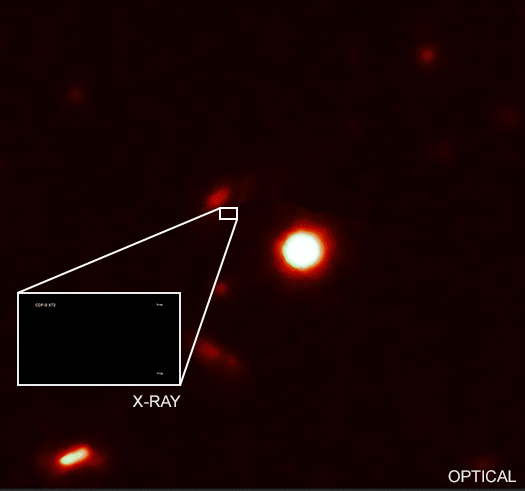For Release: April 16, 2019
NASA/CXC

Credit: X-ray: NASA/CXC/Uni. of Science and Technology of China/Y. Xue et al; Optical: NASA/STScI
Press Image, Caption, and Videos
A bright burst of X-rays has been discovered by NASA's Chandra X-ray Observatory in a galaxy 6.6 billion light years from Earth. This event likely signaled the merger of two neutron stars and could give astronomers fresh insight into how neutron stars — dense stellar objects packed mainly with neutrons — are built.
When two neutron stars merge they produce jets of high energy particles and radiation fired in opposite directions. If the jet is pointed along the line of sight to the Earth, a flash, or burst, of gamma rays can be detected. If the jet is not pointed in our direction, a different signal is needed to identify the merger.
The detection of gravitational waves — ripples in spacetime — is one such signal. Now, with the observation of a bright flare of X-rays, astronomers have found another signal, and discovered that two neutron stars likely merged to form a new, heavier and fast-spinning neutron star with an extraordinarily strong magnetic field.
"We've found a completely new way to spot a neutron star merger," said Yongquan Xue of the University of Science and Technology of China and lead author of a paper appearing in Nature. "The behavior of this X-ray source matches what one of our team members predicted for these events."
Chandra observed the source, dubbed XT2, as it suddenly appeared and then faded away after about seven hours.The source is located in the Chandra Deep Field-South, the deepest X-ray image ever taken that contains almost 12 weeks of Chandra observing time, taken at various intervals over several years. The source appeared on March 22nd, 2015 and was discovered later in analysis of archival data.
"The serendipitous discovery of XT2 makes another strong case that nature's fecundity repeatedly transcends human imagination,"said co-author Niel Brandt of the PennsylvaniaState University and principal investigator of the relevant Chandra Deep Field-South.
The researchers identified the likely origin of XT2 by studying how its X-ray light varied with time, and comparing this behavior with predictions made in 2013 by Bing Zhang from the University of Nevada in Las Vegas, one of the corresponding authors of the paper. The X-rays showed a characteristic signature that matched those predicted for a newly-formed magnetar — a neutron star spinning around hundreds of times per second and possessing a tremendously strong magnetic field about a quadrillion times that of Earth's.
The team think that the magnetar lost energy in the form of an X-ray-emitting wind, slowing down its rate of spin as the source faded. The amount of X-ray emission stayed roughly constant in X-ray brightness for about 30 minutes, then decreased in brightness by more than a factor of 300 over 6.5 hours before becoming undetectable. This showed that the neutron star merger produced a new, larger neutron star and not a black hole.
This result is important because it gives astronomers a chance to learn about the interior of neutron stars, objects that are so dense that their properties could never be replicated on Earth.
"We can't throw neutron stars together in a lab to see what happens, so we have to wait until the Universe does it for us," said Zhang. "If two neutron stars can collide and a heavy neutron star survives, then this tells us that their structure is relatively stiff and resilient."
Neutron star mergers have been prominent in the news since the advanced Laser Interferometer Gravitational-Wave Observatory (LIGO) detected gravitational waves from one in 2017. That source, known as GW170817, produced a burst of gamma rays and an afterglow in light detected by many other telescopes, including Chandra. Xue's team think that XT2 would also have been a source of gravitational waves, however it occurred before Advanced LIGO started its first observing run, and it was too distant to have been detected in any case.
Xue's team also considered whether the collapse of a massive star could have caused XT2, rather than a neutron star merger. The source is in the outskirts of its host galaxy, which aligns with the idea that supernova explosions that left behind the neutron stars kicked them out of the center a few billion years earlier. The galaxy itself also has certain properties — including a low rate of star formation compared to other galaxies of a similar mass — that are much more consistent with the type of galaxy where the merger of two neutron stars is expected to occur.Massive stars are young and are associated with high rates of star formation.
"The host-galaxy properties of XT2 indeed boost our confidence in explaining its origin,"said co-author Ye Li from Peking University.
The team estimated the rate at which events like XT2 should occur, and found that it agrees with the rate deduced from the detection of GW170817. However, both estimates are highly uncertain because they depend on the detection of just one object each, so more examples are needed.
"We've started looking at other Chandra data to see if similar sources are present", said co-author Xuechen Cheng, also of the University of Science and Technology of China. "Just as with this source, the data sitting in archives might contain some unexpected treasures."
A paper describing these results appeared in the April 11thissue of Nature. NASA's Marshall Space Flight Center in Huntsville, Alabama, manages the Chandra program for NASA's Science Mission Directorate in Washington. The Smithsonian Astrophysical Observatory in Cambridge, Massachusetts, controls Chandra's science and flight operations.
Other materials about the findings are available at:
http://chandra.si.edu
For more Chandra images, multimedia and related materials, visit:
http://www.nasa.gov/chandra
Media contacts:
Megan Watzke
Chandra X-ray Center, Cambridge, Mass.
617-496-7998
mwatzke@cfa.harvard.edu


